M. Isidora Forrest's Blog
September 7, 2025
More Weaving Magic
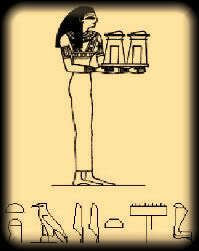 Tayet with Her name in hieroglyphs below
Tayet with Her name in hieroglyphs belowThe new publishers of Isis Magic, REDFeather, and I have been working on updates and edits to the book. Which means I have been re-reading everything—even things I haven’t seen in quite a while. I’m glad to say I’m still happy with it, and even happier having been able to make the edits. 25 years is a long time.
One of the deeper-level initiation rituals in the book is The Ritual of Becoming the Beloved of Isis. It involves three ritualists who takes the roles of Isis, Nephthys, and Tayet. And part of the magic they/They do is weaving magic. Weaving has had my attention lately, especially since last time I shared a bit about a vision of weaving magic with Nephthys.
So this time, let’s look at some of the connections between the three magical Weaving Goddesses, Isis, Nephthys, and Tayet. In the initiation rite I mentioned, the initiand symbolically dies, is mummy wrapped, and is eventually reborn as the Beloved of Isis. Since Tayet is the Linen Goddess Who weaves the mummy wrappings, it is fitting that She be part of the rebirthing.
Yet the connection between Isis, Nephthys, and Tayet is more interesting than that.
 A modern illustration of an ancient Egyptian fresco of weavers at work
A modern illustration of an ancient Egyptian fresco of weavers at workAs is true of many of the Egyptian Deities, scholars are unsure as to the origins of the worship of Tayet. Judging by Her name alone, it may be that She was first worshiped in the Lower Egyptian “weaving town” of Tayet. As far as I can tell, the town itself has not been found, just written references to it. Later, Tayet was an alternate name for Buto in the Egyptian delta…and it may be that the weaving town of the inscriptions was actually Buto from the beginning. Indeed, the first evidence of Egyptian weaving comes to us from Lower Egypt during the Neolithic period.
An inscription from the Upper Egyptian temple of Hathor in Dendera says that Tayet was born in Dendera. Yet the Dendera shrine in which this inscription occurs bears the name of a shrine in Buto, and so it makes a good deal of sense to continue to strongly connect Tayet with Buto.
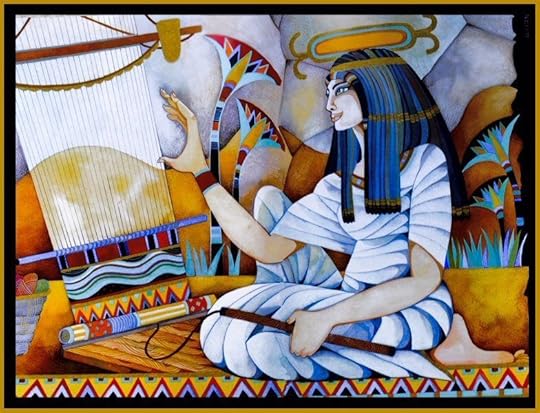 This lovely illustration by Christina Balit isn’t Tayet, but Neith, another Goddess of Weaving, and a Creator Goddess
This lovely illustration by Christina Balit isn’t Tayet, but Neith, another Goddess of Weaving, and a Creator GoddessIf Buto was Her original hometown, it is worth noting that Buto is not very far at all from Isis’ great temple at Isiopolis. (Please see my notes on Isiopolis here to see why I think the site may be a very old Isis site, even though the visible ruins are late.)
Since both Isis and Nephthys are weavers (They are specifically known as the Abuti, or Two Weavers), it makes sense that Tayet would become connected to Them. But here’s another very interesting connection: Tayet also has the form of a kite hawk, the sacred raptor of both Isis and Nephthys, and She can also be connected to a Horus:
While the Great One sleeps upon his mother Nut, your mother Tayet clothes you, she lifts you up to the sky in this her name of ‘Kite’; he whom she has found is her Horus. —Pyramid Texts, Utterance 417
Also interesting is the fact that Isis’ temple at Isiopolis makes much of Her connection with the kite, or djeret. So we have three Goddesses—all three connected with the kite, with weaving, with rebirth of the dead—and also with purification.
Old Kingdom texts refer to a woman called the Kite who was the pharaoh’s chief female funerary attendant and who was supposed to “remove poisons” from the deceased. The linen itself is part of that process and is considered to be divinely pure: An ancient Egyptian medical spell meant to prevent bleeding, warns against “treading on what is pure, the land of Tayet.” In other words, the spell is intended to keep blood from seeping from the wound and staining the pure bandage woven by the hand of the Goddess Herself.
 Modern Egyptian woman and girl weaving one of the ancient patterns
Modern Egyptian woman and girl weaving one of the ancient patternsThe purificatory role of the Kite was sometimes associated with Tayet; at other times, two ritualists were designated as Kites and connected with Isis and Nephthys. In addition to Their role in purification, the Divine Kites were responsible for ferrying the pharaoh—and Osiris—to the otherworld. See more about the Kites here.
The first pictorial representation of Tayet that we have left to us is from the Osiris chapel at Karnak. She is shown as a human woman holding two pieces of cloth and facing Isis and Osiris. At Dendera, She is shown a number of times, including some instances in which She is specifically connected with Isis. By the New Kingdom, we find the hyphenated Goddess Isis-Tayet. At Kom Ombo, Tayet’s image is portrayed in a vestibule of the Birth House. So, like both Isis and Nephthys, Tayet is connected with coming into and going out of life.
And here’s an interesting speculative connection between Isis and Tayet: in Coffin Text spell 282 for “Becoming Tayet,” Tayet is said to “make a seat” for the deceased so that the person need not “lie down in the shambles” of the otherworld. Making a seat for the deceased establishes a place for them and affords protection. As Isis’ name means “Throne,” She Herself is a Divine Seat and well known as a protective Goddess. (See more about the .)
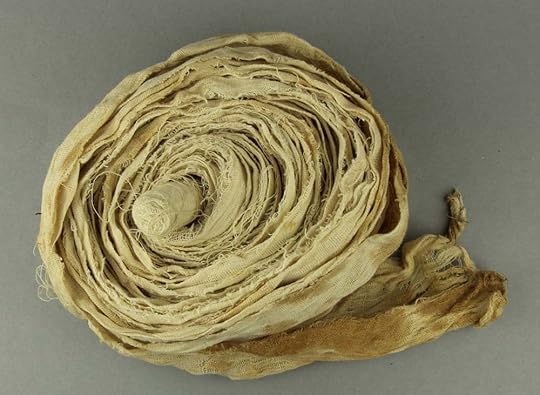 The mummy wrappings of Tayet, from a tomb
The mummy wrappings of Tayet, from a tombAt Dendera, Tayet is said to have been born with green skin. This may be a reference to the green and growing flax from which linen will eventually be made, for She is also said to be pale in complexion, like the white linen once the process is complete.
On the other hand, Tayet may be green-faced for the same reason that both Isis and Osiris are sometimes portrayed as green-faced. They are green because They are Deities associated with rebirth; They are the Living, Green Ones of the Other world; They promote each person’s rebirth like the new green shoots of plants in the fields. Tayet is said to be the wife of Nepri, the young God associated with growing grain and Whom Osiris, in His rebirth, is said to Become.
And let us not forget that more than cloth was woven in ancient Egypt. Magic was also a woven thing and weaving was one of the key methods for working magic. An ancient formula to cure a poisoned cat says that Isis has “spun something” and Nephthys has “woven something” against the poison. Numerous funerary texts say that magic is knit or woven around the deceased. The dead person is “knit together in the egg” prior to rebirth, or their head is “knit on” by the Deities. Tayet is especially called upon to ensure that the king’s head and bones don’t “become loose” during his rebirth process. Her weavings—the linen mummy wrappings and the magic that is infused in them—ensure the king’s head and bones remain stable.
 Woven magic—the heka-infused mummy wrapping
Woven magic—the heka-infused mummy wrappingMany modern magic workers would agree that the joining together of the threads of energy that are one mechanism of magic can be aptly described by actions such as weaving and knitting. The spell is woven, thread by thread, until the whole is created out of what was almost nothing. This idea can also be related to Egyptian knot magic in which the surrounding or encircling of the two ends of the knot creates the magic circle or egg within which the threads of magic are then woven to create a blanket of creative, healing, and renewing energy.
(If you’d like to know more about Tayet from ancient sources, Edward Butler of the Henadology blog has collected many of the texts referring to Tayet for us here. Thank you, Edward!)
I find Tayet strangely compelling. For a Goddess with so little specific myth, She seems to me to cast a very large shadow—or perhaps a large aura. It is almost like She is the Third Sister, joining Isis and Nephthys in all Their majesty. She intrigues me, though I can never quite get a full sense of Her. If you’ve had any contact with Tayet, I hope you’ll share it. In the meantime, may She and Her Two (adopted?) Sisters bless you.
August 31, 2025
Shapeshifting with Nephthys
It’s been a while since I made a post about Nephthys, but you might remember that She has been working with me on shapeshifting because, according to Her, She does it better than Her sister.
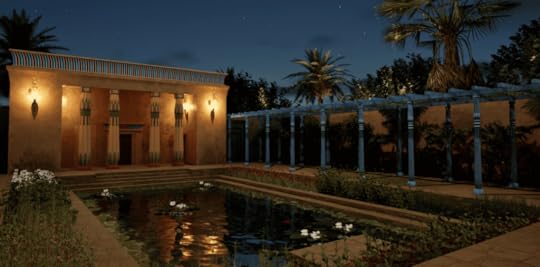
So I sat down in the shrine, purified and consecrated myself, and ran some energy to get warmed up. When I was ready, I invoked the Beautiful Sister and envisioned myself at the doors of Her temple.
She has, by the way, a most beautiful, most unusual temple. It is something like the images here, but it is always twilight there, neither day nor night; neither light nor dark.
 The garden temple of the Beautiful Sister
The garden temple of the Beautiful SisterInside is Her garden. It is gloriously lush. You can smell the greenness as you. breathe. in. deeply. Many creatures (including many fierce ones) live there with Her, hotep-peaceful in Her presence. You can smell their scents, too. Wild and sharp, warm and deep.
The doors of Her temple open to me. I enter. And I am within Her ecstatically alive garden.
My eyes adjust to the twilight as two enormous cobras glide up to me, one on each side. They rear up, spread their hoods. I understand that I am to place my hands upon their heads. They are sun-warm to the touch, their bodies strong and flexed. They guide me smoothly down a passageway to the throne room of the Goddess.

She is already there, upon Her hwt-throne.
She is shrouded in shifting darknesses—and veiled by the multiple faces that move across Her countenance. Most, but not all, are animal faces. I am reminded of those images of Hekate with Her multiple animal heads. I kneel and kiss the ground before Her beautiful face.
I ask Her, “may we shapeshift today?” (I can’t remember now whether I heard Her voice or I just knew that She’d answered, “yes.”) I become aware of Her long, long beautifully alien fingers.
I was wondering which animal it would be then. For a moment, I thought, “lioness,” because lionesses have been on my mind. But no. It was to be The Weaver. The Weaver? A human weaver? I wondered.
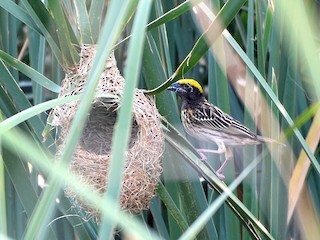 The male weaver with his yellow “hello, gorgeous” head coloring and the handsome nest he has built
The male weaver with his yellow “hello, gorgeous” head coloring and the handsome nest he has builtBut no, again.
A bird.
Now I am tiny. I am brown and white. I am inside a nest and I am weaving bits of leaves and string and twigs and straw into the interior walls of the nest. I am in a hurry, weaving deftly, but quickly. I am a female Weaver and the coming eggs must have their nest.
I am not a bird person, so I didn’t know that Egypt is home to two types of weaver birds: the Streaked Weaver and the Village Weaver.
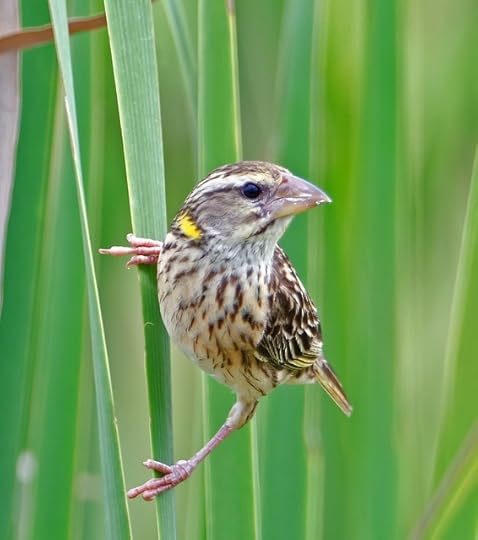 The female weaver checking out his work
The female weaver checking out his workThe Village Weaver is relatively new to Egypt and is mostly found in sub-Saharan Africa, but just recently breeding grounds have been found around Lake Nasser. The Streaked Weaver was probably established in the Egyptian delta by the period of Persian rule in ancient Egypt.
The male Streaked Weaver builds the exterior of the nest to attract the female. Once she says yes, she completes the interior of the nest, readying it for the eggs and chicks.
I am not, at present, aware of any particular connection between Nephthys or Isis and the Streaked Weaver. There’s plenty of bird and egg symbolism generally from ancient Egypt, of course. For instance, the innermost sarcophagus was sometimes referred to as “the egg.” There’s a Pyramid Text where Isis and Nu are discussing how the king will “break out of his egg” to be reborn. They decide that while Isis has formed him within the egg, all the Deities will help him break free. Eggs were placed in some tombs as symbols of new life. Bird-winged Goddesses protect the process of rebirth with Their powerful, feathered wings.
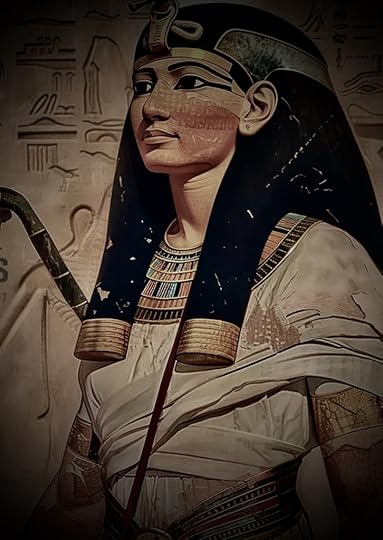
But that wasn’t it. “It isn’t about the eggs,” I think.
And now I am an ancient Egyptian magician, weaving magic.
“Oh,” I think at Her. “Yes,” She smiles back.
I am in a small chamber with plain walls. There are no windows and a single door. The place has an alchemical and underground feel to it. There are jars and potions and books (so, I can read!) on a central table. The room is lit by wall sconces holding torches. Yet the central focus of the room is a large loom.
But there’s no thread in the loom.
Instead, I understand that the loom frame serves as a kind of scrying space, an aid to the magician for weaving hekau, magics. “May I practice a spell? I ask. “Yes, She says.”
I stand before the loom frame and strongly sense Her behind me. Aaaand… then I realize that the shapeshift I am to do today is shapeshifting into Her. “Okay, I know this,” I think. “I can do Kheperu.” She smiles indulgently and turns me to face Her. In Her long-fingered hand is an egg. (Oh crap. Apparently, it is about the eggs. She is teaching me that Her magic always begins with a natural prototype.) With Her other hand, She reaches into my chest, opens the vessel of my heart (for it is a jar-like vessel at the moment) and places the egg within.
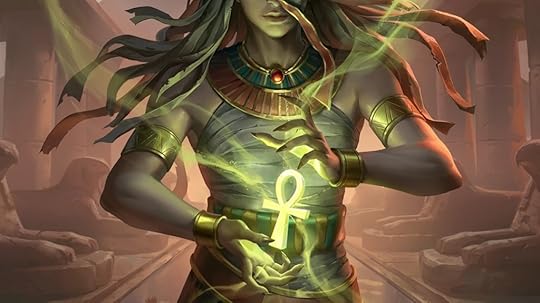
The world starts spinning clockwise and I understand that time is passing. At length—but in no time—the egg grows to envelop me. At length—and when I am ready—I make the Sign of Opening the Shrine before me. The egg cracks open. I emerge as She. With multihued wings, long, long fingers, and large, narrow eyes. I am the Weaver, Great of Magic. My body feels long everywhere. My mind is filled with Everything. I am a thread of magic. I am the weaver of the threads.
I turn to the loom and know its name: She is Becoming. In the frame I see the desired end result of My Weaving, My Spell, My Working. I know precisely what it takes to weave it. My long fingers pluck threads from across time and space, knotting them together. I knot connections between people—many people my human self does not know. There are an astonishing number of threads to knot together to create this Weaving, this Spell, this Working.
I knot the threads. Over and over.

When the intricate knotting is complete, I let down a single thread, down to the floor. There, a scarab beetle collects the thread, gathering the Weaving into Her dung ball, where Her Child awaits its Becoming.
Time passes. I watch.
I see the One Becoming, the Scarab Child, as it is born. It emerges from the solar dung ball, spreads its elytra, its shell-like wing covers, to flutter-dry its new wings. Then, in a beautiful, green iridescence, it flies up to land on My index finger. The Magic is born.
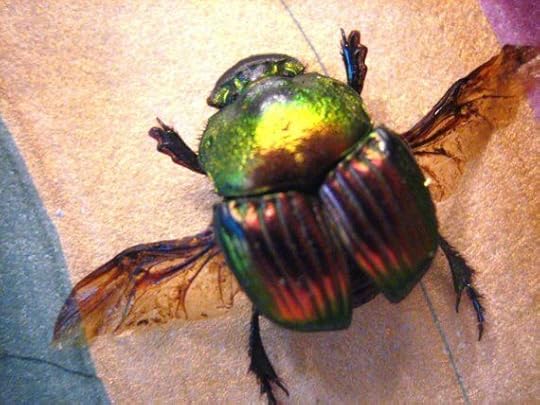
I-Nephthys open My bird wings and fold them about Myself. In an instant, I am the magician, Becoming the egg once more, the egg within my heart. “Leave it there,” says Nephthys, Tasenetnoferet. “It is the seed of your Becoming.”
I thank Her with all my egg-heart.
And now, I am back before Her throne, within Her garden temple. I kiss the ground before Her beautiful face. The cobras return, guiding me back to the outside world. The vision fades.
I am once more in my own shrine, where I make offering unto Nephthys. M’den, Tasenetnoferet. Accept it, Beautiful Sister.
August 24, 2025
Isis & the Wandering Goddesses at Philae
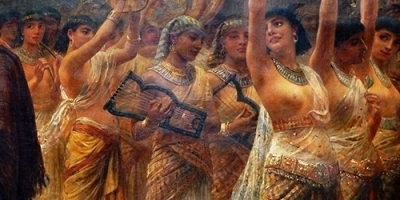 Procession for Her return
Procession for Her returnIf you’ve been reading along with this blog, you may know that I believe we should count Isis as one of Egypt’s Wandering Goddesses. You can read about that here, here, and here. As we recently had our local Summer Solstice festival—in which we honored the Wandering Goddesses Sakhmet and Hathor—well, Wandering Goddesses are on my mind.
So, I’d like to uncover for you some of the footprints of the Wandering Goddess that we can find at Isis’ famous temple at Philae. (Read more about that beautiful temple here.) You may recall that Philae is located at what was the southernmost border of Egypt.
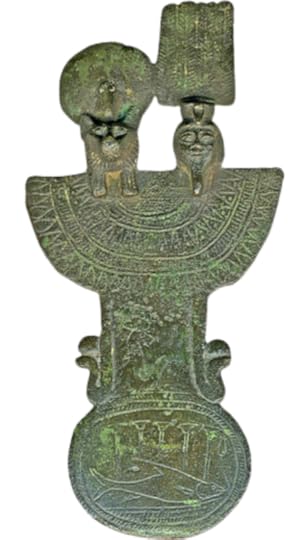 Tefnut & Shu on a menat weight
Tefnut & Shu on a menat weightIn the Wandering Goddess myths, when the angry Goddess leaves Egypt, She often goes south “to Nubia” (i.e. “gets the hell outta here“). Famously, Tefnut—Isis’ grandmother—is one of the Goddesses Who specifically goes to Nubia. Eventually, She is coaxed back by Thoth in the form of a fable-telling monkey. As Tefnut returns, She travels north from Nubia. Thus, Isis’ temple at the southernmost outpost of Philae is the Goddess’ first stop on Her return trip home.
But since we’re talking about Egyptian Goddesses here, everything is a little bit more complicated than that. Because when Tefnut makes Her stop at Philae, She is not just Tefnut, but also Hathor and Wepset. We can only unconfuse this confusing situation if we remember the way that Egyptian Deties have of flowing into or “coming forth as” each other at any moment. (And you might recall that Hathor has a small temple at Philae just as Isis has a small temple at Dendera, Hathor’s home turf.)
Wepset may be new to you, though. She is a Goddess Whose name means “She Who Burns;” thus She is another of the forms of the Flaming Goddess, the Uraeus Goddess, the Solar Eye Goddess. In Egyptian texts, Wepset is often depicted simply as a uraeus serpent, but in Nubia itself, She is shown as a woman with a uraeus serpent upon Her head. She, too, “returns from Nubia.” Sometimes, like Hathor and Tefnut (and Isis), Wepset also wears the solar horns-and-disk crown.
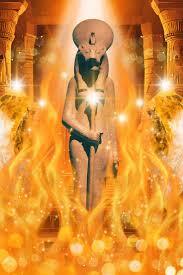 The burning lioness
The burning lionessWepset is also associated with the island of Biggeh, near Philae. Biggeh is a tomb of Osiris and Isis travels there every ten days to pour libations for Him. There, it is recorded at Philae, Wepset cooled Her rage. On Philae island itself, Wepset appears—in Her form of Hathor—in the mammisi, or birth house, where Isis bore Her son Horus.
The Gods are just as fluid as the Goddesses. At Philae, the Wandering Goddess/es are coaxed back to Egypt by Shu, Tefnut’s consort. Yet He also has a variety of names and forms, notably Onuris and Arsenouphis. Onuris, Anhur or Inhert in Egyptian, is a warrior and hunter. He is tied to the Wandering Goddess theme as the one Who brings back the wandering Lioness Goddess Mehyt. He also has sky associations and so is easily connected with Shu, Lord of the Air. Arsenourphis (Egyptian: Iry Hems-nefer, “the Good Companion”) is a Nubian God Who appears at Philae in a capacity similar to Onuris and Shu. Thoth, in several forms, serves as another of the amelioraters of the Goddess’ rage at Philae.
The book I’m reading about all this is by French Egyptologist Danielle Inconnu-Bocquillon. She says that there are no complete tellings of the Wandering Goddess myth at Philae, just references to key events in the myth. She notes that the parts of the myth we see at Philae are specific to Philae—as seems to be generally true in the temples. Each temple has their own specific version and details about their own Wandering Goddess in all Her many and varied forms.
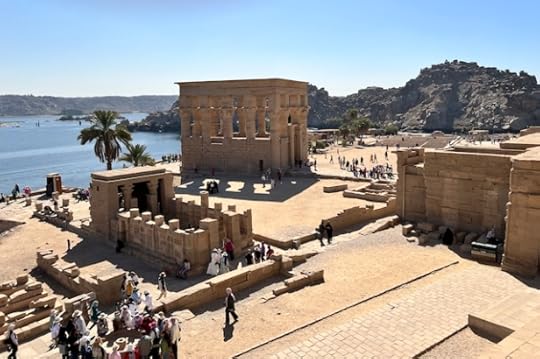 From the roof of Isis’ temple, the small Hathor temple is the structure to the left
From the roof of Isis’ temple, the small Hathor temple is the structure to the leftAt Isis’ temple of Philae, the angry Goddess is Tefnut-Wepset. The one Who brings Her back is Shu, in several of His forms, including as Thoth. The Returned Goddess is Hathor, which would explain the presence of a smaller Hathor temple on Philae. Apparently, there is, however, no specific reference to the myth in Hathor’s small temple. But the inscriptions and decorations of this temple were never finished. So I’m going to guess, there would have been such references.
Nevertheless, there are quite a lot of flame-y Goddesses at Philae. As Philae is the first temple the Wandering Goddess comes to as She returns from Nubia, that makes sense. Sakhmet is there as Mistress of Flame. Tefnut is Lady of the Flame in the House of Flame. The Goddess Satet, the Archer Goddess of the southern border, is also Mistress of Flame, as is Wepset. Mut appears as well as the Returning Goddess and thus She has a fiery form, too. Hathor is a Mistress of Flame and is shown as a dangerous Goddess at Philae. All the Goddesses are Eyes of Re and They are coming in HOT. They have not yet been made hotep, “satisfied” or “pacified.” As She/They arrive at Philae, Their anger is not yet cooled. Indeed, when the Goddess arrives at Philae, She is “surrounded by a large flame.”
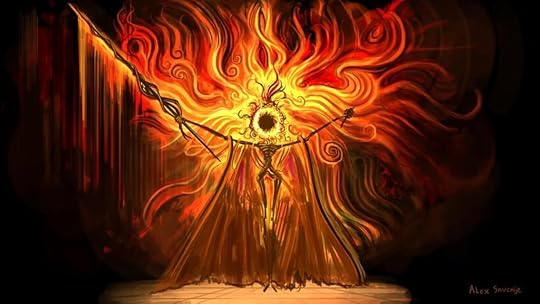 Art that reminds me of the Solar Eye Goddesses; by Alex Saveniji
Art that reminds me of the Solar Eye Goddesses; by Alex SavenijiWhat’s more, in the company of these Fiery Goddesses, Isis is Herself rather fierce. She is called Great of Magic Who Resides in Philae, Regent of Nubia, Great of Carnage in the Place of Execution, Mistress of Combat, Lioness, and Mistress of Slaughter. In fact, Isis and Tefnut share the very same furious epithets at Philae. And at least one inscription at the temple complex has Isis Herself arriving and “resting” at the Abaton (“untrodden” i.e. “pure” place)—something that the Returning Goddesses routinely do.
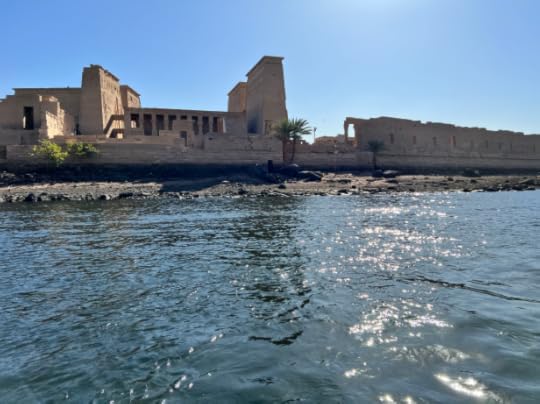 The holy island of Philae (Agilika) in the cool waters of the turquoise Nile
The holy island of Philae (Agilika) in the cool waters of the turquoise NileThe other thing that the Returning Goddesses do is to be purified and appeased so that Their angry, fiery Forms may be cooled—and the joyous festival of Their return celebrated. At the Abaton, we find Nephthys, Isis, Wepset, and Hathor all being appeased.
In the Philae area, the Abaton is the island of Biggeh, which has a tomb of Osiris. Isis visits there every 10 days to pour libations for Him.
So here’s how that goes: the inscription says that Isis, as Wepset (the angry Goddess), returns from Nubia and stands upon the High Hill (that is, the tomb of Osiris). There She is appeased, then settles in Philae “in Her name of Hathor.”
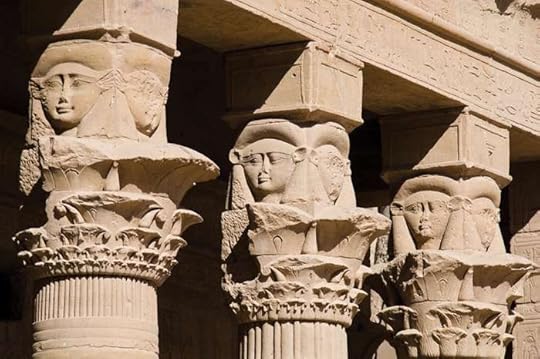 Hathor on the mammisi on Philae
Hathor on the mammisi on PhilaeSettled at Philae, wensheb—a type of waterclock associated with Thoth and offered to Wandering Goddesses as a symbol of return to Right Order—is offered to Isis, Who is accompanied by Tefnut, and to Isis, Who is accompanied by Hathor—as well as the other Fiery Eye Goddesses.
It seems that, as the Lady of Philae, Isis is all these Goddesses; and that They are all Her. The more I get to read the actual temple inscriptions from the actual temples, the more it becomes clear not that “All the Goddesses are One Goddess” as Dion Fortune’s famous aphorism says. But instead, when it comes to Egypt, “All the Goddesses are All the Goddesses.”
Oh yes, there’s much more to delve into here.
But for now, I am going to leave you with a hymn to Hathor Who Is Isis and Isis Who is Hathor, from Hathor’s small temple at Philae. Perhaps you will find it useful in your own invocations of Our Lady.
“How beautiful is Your face when You appear in glory and joy, Great Hathor, Lady of Senmut, Venerable Hathor, Lady of the Enclosure of the Calling. Your father Re exults when You arise, Your brother Shu pays homage to Your face. Thoth, powerful in intoxicating drink, He calls, O Powerful One. The Great Ennead is in pleasure and joy, the baboons are before Your face and dance for Your Majesty, the Hity beat the tambourines for Your ka, the Beings sing hymns for You and worship You. The Henemenet bow before Your power, men and women pray to you to give them love. For You the virgins open the festivities and give You their protective spirit. You are the Mistress of Praise, the Mistress of Dance, Great in Love, Mistress of Women and the Beautiful. You are the Mistress of Drunkenness, of Many Feasts, the Mistress of Frankincense, the Mistress of Braiding the Crown, the Mistress of Gaiety, the Mistress of Exultation to Whose Majesty Music is Made; Venerable Female Pillar, Female Ba in Bougem; You are the Mistress of the Sakhem Sistrum [the loop sistrum], the Mistress of the Menat and the Seshesh Sistrum [the naos sistrum] to Whose ka the wensheb [a type of waterclock associated with Thoth and offered to Wandering Goddesses as a symbol of return to Right Order] is raised. You are the Mistress of Dance, the Mistress of Song and Dance to the Lute, Whose Face Shines Every Day, She Who is Ignorant of Sorrow. May You be present in Your Beautiful Face.”
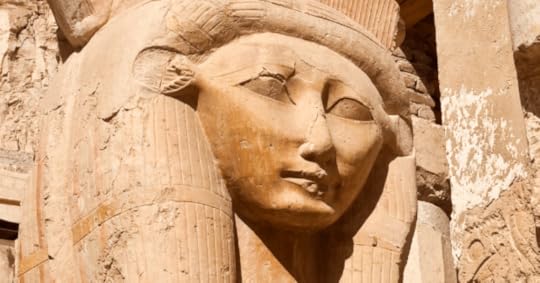 Hathor, in Her Beautiful Face
Hathor, in Her Beautiful Face
August 17, 2025
Is Goddess Isis Calling Me?
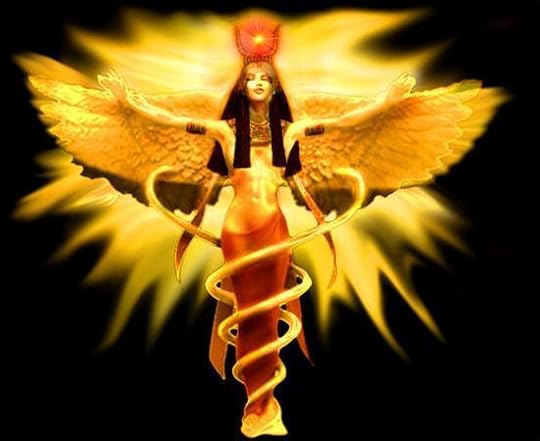
Hello, all! Yes, this is a repost. But it’s with good cause.
I just received files of the NEW 25th Anniversary Edition of Isis Magic, which I must review and proof on a deadline. So I’m working on that today . It is scheduled to be out next spring!
So I hope you’ll enjoy this post again—or even better—share your own story of how Isis came to you.
One of the questions I regularly receive from folks who email me is, “how can I tell if Isis is calling me?”
It’s a very good question, if a somewhat difficult one to answer. Sometimes, people have had dreams with what they think could be Isiac imagery. Sometimes they’ve had a vision or some other experience during a ritual. Sometimes it’s a feeling, sometimes a wish or a hope.
What Do We Mean by “Calling”?
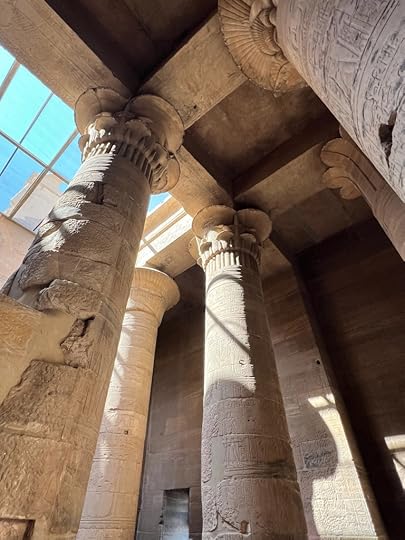
To try to unravel this, the first thing we need to figure out is what we mean by “calling?” In other words, if She were calling us, what would that mean? What kind of obligation, if any, comes with that calling? Because so many of us have Christianity in our personal backgrounds as well as Christianity being so prominent in our societies, we might automatically associate “a calling” with a vocation for the ministry or priesthood. It’s certainly possible. But there are other possibilities, too.
What calling means to us can also depend on where we are in our spiritual journey, as well as what we’ve been studying or reading or thinking.
For instance, let’s say you’re very interested in ancient Egypt, you’ve been reading about it, and you’re in a spiritual circle of some kind that regularly invokes Deities. Then one night, you have a powerful dream in which a beautiful, Egyptian woman seems to welcome you. You think She might be Isis. She might, indeed. She could also be one of any number of Egyptian Goddesses, which you would know about from your reading. What you intuit from your own dream will be very helpful here. If you think She’s Isis, you can follow that thread. We’ll talk about that shortly.

For another instance, let’s say you’ve never had any particular connection with ancient Egypt and you’re not on any specific spiritual path. Then one night, you have a powerful dream in which a beautiful, Egyptian woman seems to welcome you. You think She might be Isis. This may be just a dream. But if you find it exceptionally powerful, keep looking. A dream like that might be pointing out that your soul is yearning for some positive Mother or Divine Feminine energy in your life. That knowledge, in and of itself, is very valuable information. On the other hand, such a dream could be the impetus to set you on a spiritual journey as you seek to learn more.
And for a third instance, let’s say you have that same dream. But you don’t feel that you’re ready—or that you even want to—do anything about it. You absolutely don’t have to. If it’s an important knock on your spiritual door, She’ll knock again. And it’s okay to say no. You won’t hurt Her feelings and there are no negative consequences.
Dreams & Signs
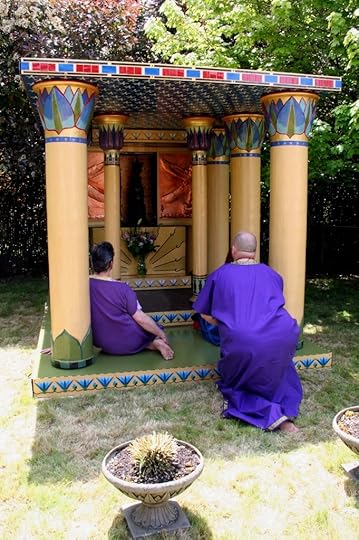
So. Dreams are one way to hear Isis if She’s calling you. But if you, like me, are a crappy dreamer and neither remember them nor write them down, there are other ways to hear Her. There are usually signs. Signs can be tricky. In most cases, a sign is something unusual that catches your attention and relates to the particular Deity involved, in our case, Isis. Because She is a Bird Goddess, it might be wings and feathers. You may hear the sound of wings at an odd time. Or a bird swoops down immediately in your line of sight, startling you. Or a feather drops from the sky. Her symbols—like the Knot of Isis or a throne—might show up unexpectedly. Perhaps you overhear Her name in a passing conversation between strangers. This will happen, not just once, but many times. Be patient. Wait. And look and listen for the signs.
Now, if you’re actively wanting Her to be calling you, signs and synchronicities can ramp up. Does a breeze rustle the leaves of a tree as you pass, thinking of Her? It is Her breath. Have you found a piece of jewelry engraved with Her image? She confirms your Path. Did that hawk circle above you as you drive your car down a country road with Her name on your lips? She is guiding you.
Is it foolish to see these signs everywhere? Is it “just my imagination?” In some cases, sure, there will be a kind of confirmation bias. But that doesn’t matter; She’s on your mind. You’re thinking of Her. It has begun.
Sometimes, there are other ways to tell. You might have an intuition of Her presence about you. Or something weird might happen. I’ve had incense burn and disappear all by itself, strangers have given me unexpected Isis gifts, very loud disembodied voices have spoken my name. What your weird thing might be, I can’t say.
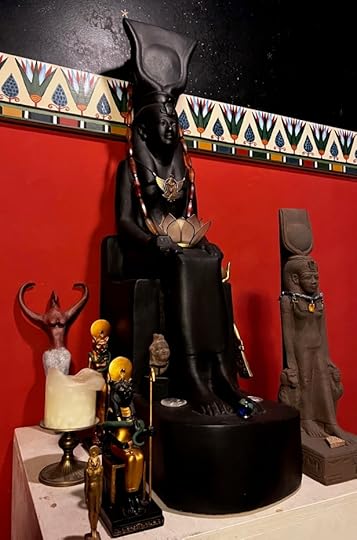
Pick Up the Phone Yourself
Now. There’s also an important secret about all this that I’d like to share with you. Two, really. The first is that if you want to connect with Isis, you don’t have to wait for Her to call you. You can call Her, too. Light a candle. Say a prayer. Ask Her to come into your life. If you like ritual, use the Opening of the Ways here.
The second is that being called by Isis doesn’t necessarily mean you are being called to a lifelong relationship with Her. It doesn’t necessarily mean you’re being called to serve as Her priestess, priestex, or priest. It might mean you’re being called to learn more about Her—right now and perhaps only for a while. Perhaps you’re being called to relationship. And like any relationship, that means investing time. Spend time with Her, in meditation and prayer. Read about Her in anything and everything you can get your hands on. Get to know Her. See how She feels to you. Do you like Her energy? Does it fit with yours? That’s what I mean by following the thread…and just see where it leads you.
And if you find, after time, that this is not the relationship for you, that’s perfectly okay. You will have learned. You will have grown and your spiritual world will have been expanded.
But if you find that, like me, you are a lifetime (or at least long term) devotee of Isis, then I know you will discover for yourself Her deep love, wisdom, power, and magic.
August 10, 2025
Isis, Flint Knives, Mooring Posts & Stars
Part 2
Last time we saw how the ancient Egyptian constellation of Iset Reret—in Her upright-hippopotamus-with-a-crocodile-on-Her-back form—was envisioned as using a flint mooring post and golden chains to keep the constellation of the Foreleg of Set in its proper place in the heavens.
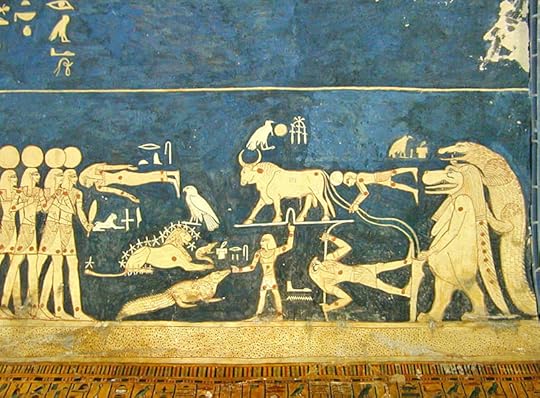 The mooring post secures the stars
The mooring post secures the starsThis time we’ll look into the symbolism more deeply and then see how we could use this information in spiritual and magical Work with Isis.
The Mooring Post
In case you’re not a sailor, a mooring post is a sturdy post to which you can tie your boat to keep it in one place, i.e. moored. You might find them on a dock, or if you were an ancient Egyptian, driven into the banks of the Nile river.
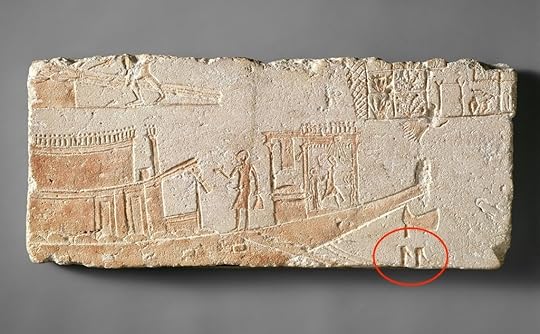 A royal barge moored by twin mooring posts, circled in red
A royal barge moored by twin mooring posts, circled in redJust as mooring posts were common in ancient Egyptian daily life, so they were important in the afterlife. The deceased traveled through the Otherworld by boat, and secured their boats in their final destinations by means of a mooring post. In the Coffin Texts, the deceased declares that “my boat shall be brought to me, the mooring post shall be driven in for me.” Because of the importance of the mooring post in this context, “coming to moor” became an Egyptian euphemism for “to die.” Death itself was referred to as the Great Mooring and every Egyptian hoped to safely reach their individual mooring post.
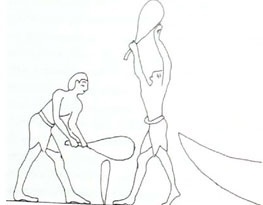 Driving in the mooring post
Driving in the mooring postThe Great Mooring Post, Menit Weret, is a Goddess, She Who calls us to our deaths and Who protects us, moored securely, after death. When we know Her name, She is none other than Isis. “The Mooring Post summons you as Isis,” say the Pyramid Texts, “the Mourning Woman calls to you as Nephthys.” Being called by the Great Mooring Post is a very good thing and ensures the dead will have a stairway to heaven set up for them, among other benefits.
In some cases, a mooring post could serve as a type of pillory to which to bind an enemy for punishment. In a text now in the British Museum, an enemy of Re, Maga, son of Set (make of that what you will), is bound to a mooring post of Osiris. Mooring posts were also part of temple equipment and were used (ritually, I assume) to subdue enemies as well as ensuring ongoing rejuvenation for the Deities of the temple. Overall then, the symbolism of the mooring post as well as the Great Mooring Post, Our Lady Isis, is magical power, stability, and a secure and protected afterlife.
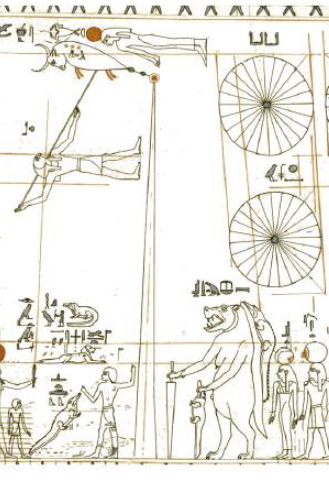 Iset Djamet with mooring post
Iset Djamet with mooring postIn the sky, stars envisioned as mooring posts were also associated with Orion’s belt (and thus with Osiris) as well as with the Imperishable Stars. Both Isis and Nephthys can be connected with mooring posts; indeed, we often see twinned mooring posts illustrated in tombs. The Two Sisters also open the Double Doors of Heaven, which open the way to ongoing rebirth. (Might the Mooring Post Goddesses also serve to keep the heavenly doors open, as a kind of Divine Doorstop?) In the northern sky, the mooring post that anchors the Foreleg of Set is near the north pole, so some Egyptologists suggest that it might have been seen as a kind of divine pivot around which the heavens turn.
In the tomb of Rekmire, an Egyptian noble, we see two mooring posts/Mooring Posts to which or Whom a bull’s foreleg is being offered. A female figure watches as a bull is sacrificed (remember the Kite from several weeks ago?) while two female figures mourn beside the two mooring posts. They are not labeled, but it would make sense if They were Isis and Nephthys or priestesses representing Them. Egyptologist Harco Willems sees this offering to two mooring posts/Mooring Posts as part of the vigil of Osiris.
As we saw last week, the mooring post and the knife are often interchangeable in ancient Egyptian art, and both could be made of flint. Isis Herself IS the Great Mooring Post and She often carries and uses a knife. Sometimes, She uses a knife to fight off the enemies of Re, such as the Great Serpent Apophis. On a more mundane level, flint knives could be used to protect against and treat snakebite. Isis also has a special knife for cutting the birth cord of Horus, the name of which the dead needed to know to proceed in the afterlife. In a myth recorded in the Papyrus Jumilac, Isis shapeshifts into a bitch with a knife at the end of Her tail in order to fight Set. And, as a knife-wielding Goddess, Isis is a warrior—for Deities like Osiris and Re as well as for the king.
 Egyptian flint knife or des
Egyptian flint knife or desArchetypally, Isis’ knife surely would have been the primordial knife, the knife of flint.
Flint & the Flint Knife
Flint is a type of cryptocrystalline quartz that typically forms in sedimentary rocks. It has two very special characteristics. First, it breaks in such a way that very sharp edges can be created—which is why it was used to make the first knives.
Second, because it has a high silica content, it can produce sparks when struck against another hard material, today usually steel, but another hard rock, such as quartz will also work. The Egyptians called it firestone. (Striking sparks with flint and a quartz crystal seems like a pretty dang magical way to start a ritual fire, if you ask me.)
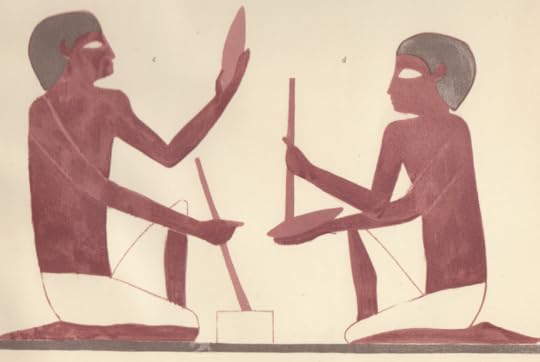 Making flint knives
Making flint knivesFlint, among other minerals, was offered to Osiris as part of His resurrection rites during the Khoiak festival, so we can connect it with that ever-present Egyptian theme, too. Ancient Egyptian flint jewelry has also been found.
In nature, flint is found in nodules which sometimes come in odd shapes that suggest other objects.
Flint is abundant in the Valley of the Kings and Queens. The villagers of Deir el-Madina, who built the tombs there, collected these natural sculptures, sometimes painted them to enhance the design, and offered them in chapels, or even had them embedded in their funereal stelae.
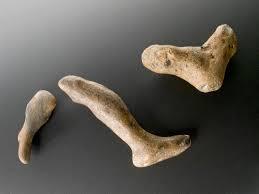 Flint in the shape of a leg and foot; not from Egypt
Flint in the shape of a leg and foot; not from EgyptSome of these similacra looked like pregnant women, a similarity that was emphasized by painting. Other flint nodules suggested various creatures such as crocodiles, serpents, or scarabs, as well as the solar and lunar disks.
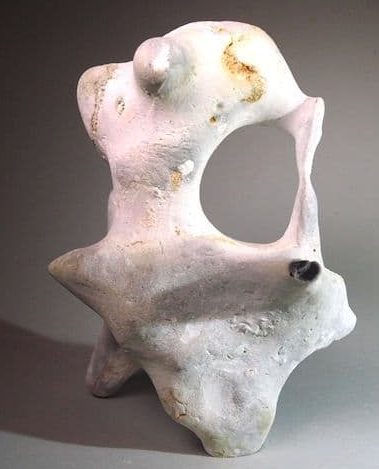 A flint nodule in a dramatic shape; you can see how this one might be enhanced by paint and carving to form a female figure
A flint nodule in a dramatic shape; you can see how this one might be enhanced by paint and carving to form a female figureThe articles I’m reading about ancient Egypt and flints says that, overall, there are several themes associated with the flint simulacra: Emergence and Primeval Creation (because they’re natural sculptures and emerge from the surrounding rock); the Feminine (because of the pregnant woman images, as well as some painted as Nuet, other Goddesses, or lotuses); and the connection between the celestial and underworld realms (because of flint’s emergence from the earth, yet its sharp and fiery nature like the stars).
In the Book of the Dead, a scepter made of flint is associated with the northern sky, wind, and breath; its name is “Breath-Giver.” In the hieroglyphs for this passage, the scepter is shown as a was (“power”) scepter. And the was scepter was associated with Set. Two was scepters were the emblem of His nome of Oxyrhynchus and the head of the scepter itself may be intended to represent the head of the so-called Set beast, a creature as yet not securely identified.
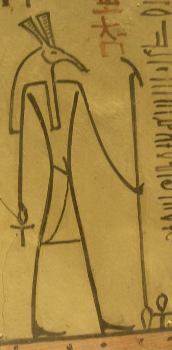 Set with was sceptre
Set with was sceptreAnother flinty connection is with the pesesh-kef, a ritual tool used in the Opening of the Mouth ritual. At least in earlier periods, it was made of flint. The Opening of the Mouth ritual was part of the rebirthing of the dead, but it could also be used to bring life to things like the sacred images in temples. What’s more, the pesesh-kef could also be used to cut the umbilical cord once the child was born, again associating it with birth as well as rebirth.
Flint was often connected with meteoric iron, another Setian material. Flint, like iron, was said to “come forth” from Set. Plutarch, in his essay on Isis and Osiris, notes that the Egyptians say that iron is the bone of Set. And right after writing that, he relates a strange story about Zeus’ (i.e. Amun or Amun-Re’s) legs having grown together so He couldn’t walk. But Isis—surely with Her sacred knife—cut free His legs so He could stride the earth once more.
Fiery Lionesses & Flint
Flint is also connected with the Return of the Wandering Goddess. It was one of the offerings given to appease the Goddess upon Her return. I don’t know, but I wouldn’t be surprised if some of these decorated flint nodules might have been offered as well, especially the woman-shaped ones. As you know, the Returning Goddess may be Hathor, Sakhmet, Tefnut, Bastet—or any of the Goddesses with a lioness or feline form—which means most of Them, including Isis. Flint is sharp like the claws of these Goddesses. Flint is fire-producing, like the very Being of these Fiery Eye-of-Re Goddesses, Who can spit fire or even turn Themselves into frightening infernos.
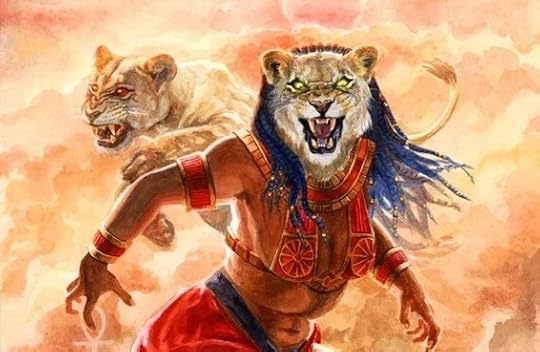
And yet these burning lionesses are also fiercely protective—of Re, of course—but lionesses are known as ferocious protectors of their cubs, just as mother hippos are of their calves.
Now What?
Interesting as all this may be, what can we do with this information in our spiritual and magical work with Isis?
For me, knowing more always gives me more magical tools in my magical toolbox. It provides me with more symbols and aspects of My Goddess to explore in my meditations—which, in turn, always opens additional insights and helps integrate the intellectual with the experiential.
We’re already familiar with a lot of the concepts we’re been discussing: fierce and protective Mother Goddesses, renewal and rebirth, the ancient Egyptian desire for stability and strength, the need to repel and subdue enemies, protective fire, magical fire, and the connection between our world and the Otherworld, both nether and celestial. Personally, I was thrilled to learn about the flint nodules that became natural talismans and offerings for the ancient Egyptians.

Here’s some brainstorming on how we might use this information in our Work with Isis:
Obtain a new magical tool, a knife or “mooring post.” Since the two are fairly interchangeable—and a knife is easier to find and more compact than a mooring post—you could buy or, if you’re crafty, make a flint knife. I might actually name my knife “Mooring Post of Isis” so that I could use it for all the purposes we’ve been discussing, from the stabilizing ability of the mooring post to the defensive capabilities of a knife.
I will definitely be trying to light a ritual fire with flint. (And I might use some flash paper as part of my tinder, as in the Rite of Capturing Sunlight, to ensure success.)
Try using a mooring post/knife to stabilize a spell. Write it down on papyrus and drive the tool through it into the ground, helping it manifest. (You could even do this indoors using a deep bowl of earth.) When the rite is accomplished, release it with proper thanks. You might do the same thing as a protection spell with the name of the enemy (doesn’t have to be a person; an enemy might also be a bad situation), written down and stabbed through.
Use the tool to stabilize yourself. If you’re feeling “unmoored,” go outside and drive the mooring post/knife into the ground. Sit on the earth and let the strength and stability of Isis uphold and support you.
Meditate with Isis, asking Her to more fully explain the mysteries of the mooring post, knife, and flint to you.
Go out on a clear night and look at the Big Dipper and Draco. See Them through the eyes of the ancient Egyptians as the constellation of Iset Reret the Hippopotamus Goddess Who secures and guards the Foreleg of Set. Meditate on what that might mean.
Purchase some flint and consecrate it as a talisman of strength and protection. I’ve even seen flint beads for making jewelry—and with the Egyptian precedent, this would be an easy and beautiful way to carry the powers of flint.
And that’s just the beginning. What ideas do you have for using the magic of flint knives, mooring posts, and the stars in your Work with Isis?
 The fiery, fierce, and sharp Eye of Re Goddess
The fiery, fierce, and sharp Eye of Re Goddess
August 8, 2025
Oh My Goddess!
I just received my author copy of the deluxe collectors’ edition of Offering to Isis from Azoth Press and Miskatonic Books.
It is simply stunning. Stunning, I tell you!
First, you see a slightly silvered, black book case with a beautiful brass ankh on the front and a gold book title on the spine of the case. Like this:
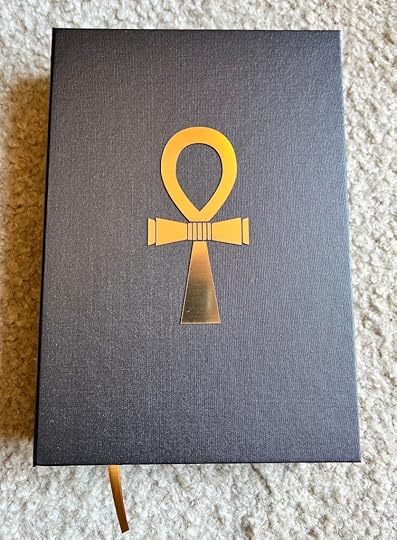 The gold ribbon is for marking your place in the book inside
The gold ribbon is for marking your place in the book insideOpen that up and you’ll see lotuses on the inside cover of the case and the cover of the book itself—in deep faience teal leather with a brass Knot of Isis on the front:
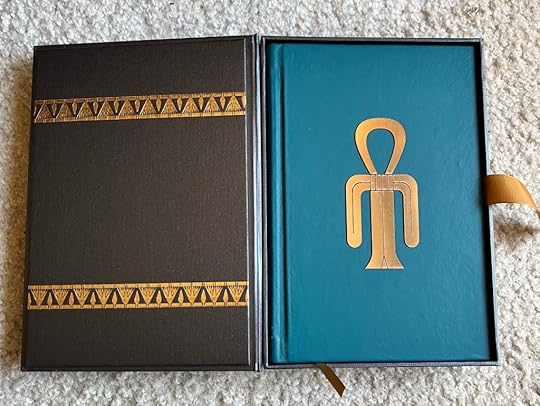 The larger gold ribbon makes it easy to lift the book our of its case
The larger gold ribbon makes it easy to lift the book our of its caseInside, there are marbled endpapers:
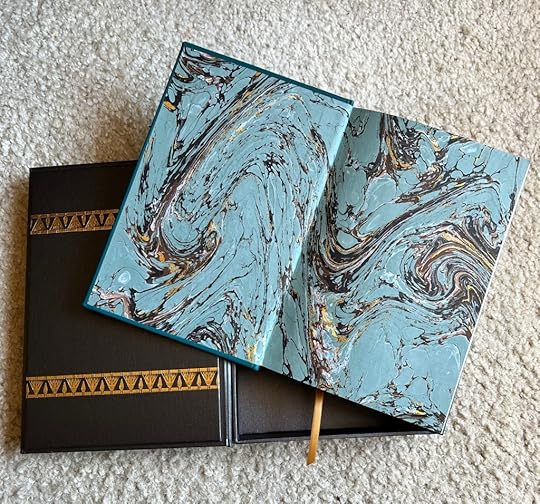
And the interior is like the limited edition version:
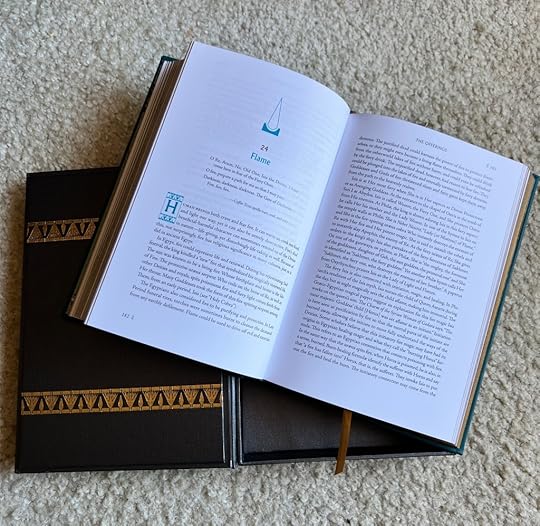
And here’s one more look at this beautiful set:
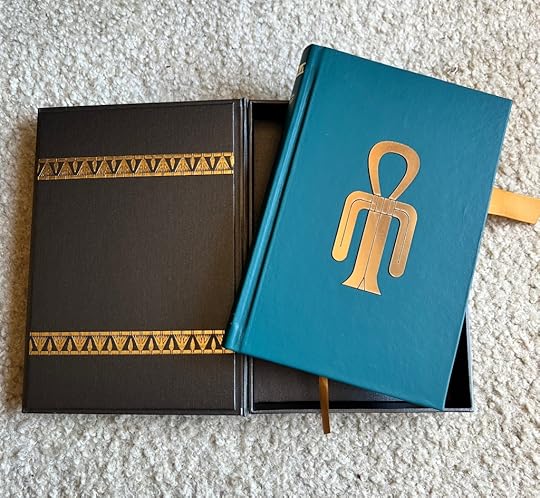
This book in itself is an offering to Isis and it is going on Her altar right now!
For the book collectors among us (you should see our library here at The Hallows), here’s the link to the only place you can get a copy: Miskatonic Books.
August 3, 2025
Goddess Isis & the Mooring Post of Flint
Part 1
If you’ve been flipping through the new edition of Offering to Isis, you may have noticed that two of Her sacred symbols—which can also serve as offerings to Her—are a mooring post and a knife.
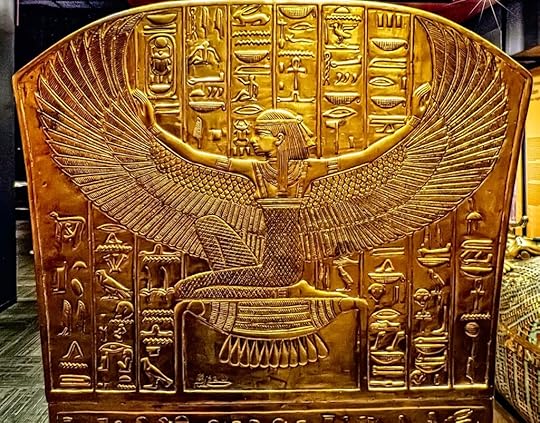 Isis protects the dead
Isis protects the deadIndeed, Isis Herself is called the Great Mooring Post, She Who calls us to our deaths. And yet the Great Mooring Post is also a comfort to and protector of the dead—and we, like Osiris, can rejoice when She greets us in the Otherworld.
The knife in question is the flint knife or des. Des just means “flint,” the material of the original knife. In ancient Egypt, the word des came to be used for all knives because of the ancient prototype.
I’m reading an article now that combines these two Isian symbols in the form of a heavenly mooring post made of flint. This is because, in the heavens, Isis as a hippo-formed Reret Goddess, uses a flint mooring post to chain the constellation Meskhetyw, “the Foreleg,” in its place in the northern night skies.
What’s all this about?
Let’s see what we can find out.
First, let’s look to the stars. There are two particular constellations involved: Meskhetyw, which corresponds roughly to the Big Dipper, and the constellation associated with Isis Reret and Her mooring post, which corresponds roughly to Draco.
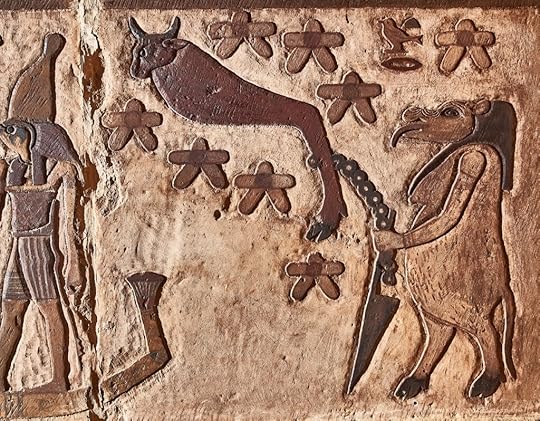 Reret chains the Foreleg in place among the stars
Reret chains the Foreleg in place among the starsBoth of these constellations are among the northern circumpolar stars. Circumpolar stars move counterclockwise around the celestial North Pole and never go below the horizon when viewed from the northern hemisphere. Because these stars could always, always be seen in the Egyptian night sky, the Egyptians called them the ikhemu-sek, the “Imperishable Stars.” They served as nightly visual proof of the everlasting celestial life that awaits us beyond death. The great Sky Goddess Nuet is described as containing the Imperishable Stars. And, of course, Her children, Isis and Osiris, are among the most important protagonists in the Egyptian understanding of life after death.
The angled khopeshThe Foreleg constellation was envisioned by the Egyptians as a bull’s foreleg. In the Pyramid Texts, it is the foreleg of Set, but it is also said to be the foreleg of a donkey or dog, beasts associated with Set. Yet, the text on the coffin of one of Egypt’s sacred bulls attributes the foreleg to Osiris, “the Bull of the Sky.” Meskhetyw might also be called the Khopesh of Set, for its resemblance to the angles of this type of Egyptian sword.
The Reret (meaning “sow”) constellation is envisioned as a female hippopotamus, standing on Her rear legs and with a crocodile perched on Her back. In different representations of the stars, this constellation is sometimes called Reret, sometime Great Reret, and sometimes Iset Djamet. By the time of the New Kingdom, the constellation is strongly connected with Isis.
A text in the tomb of Rameses VI explains it:
As to this Thigh of Set, it is in the northern sky attached to two firestone [i.e., flint] mooring posts by golden chains. It has been given in charge to Isis, in Her form of a female hippopotamus, Who guards it. The Water of His Gods is round about as Gods of the Horizon. Re has placed them behind it together with Isis, saying: “Prevent it going to the southern sky toward the Water of the Gods which issued from Osiris, He Who is behind Orion . . . They appear in the regions of the sky, in the northern sea [Egy. Wadj Wer, “Great Green;” the Wadj Wer can be identified as Osiris, with the Primordial Waters, and on earth, with the Mediterranean sea]. It is for them. The northern horizon is their country.”
Isis as a Reret Goddess
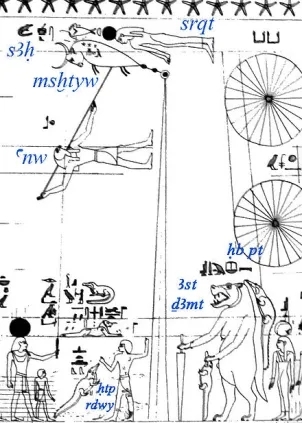
So Isis and the northern Deities, no doubt stars, guard the Thigh or Foreleg of Set. And since They are preventing the northern Waters, associated with the Foreleg of Set, from mingling with the southern Waters of Osiris, They are protecting Osiris from Set.
In the Papyrus Jumilac, from a later period, the Foreleg is said to be tethered “so that it cannot travel among the Gods.” In the temple of Esna, Reret secures the Foreleg “in order not to let it go upside down into the Duat [the underworld].”
From the tomb of Senenmut, which contains one of the key Egyptian astronomical diagrams, we find the female hippo constellation identified as Iset Djamet Heb Pet (heb pet is “heavenly festival” or “sky festival”). Djamet may be a place-name for Medinet Habu. It may also have other interpretations. Some Egyptologists suggest that djamet may refer to the crocodile on the Goddess’ back as other place-names with dja– are frequently written with the crocodile alone. Dja by itself could mean a firestick (remember the flint above) or—interestingly—a warrior form of Ishtar.
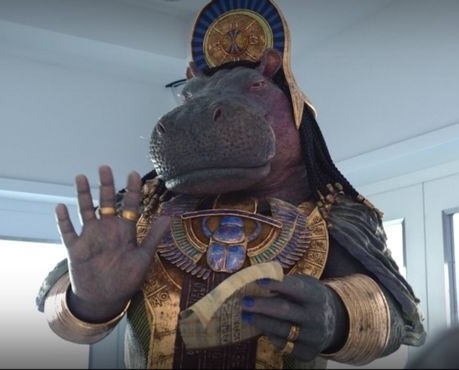 Taweret from Moon Knight; I kinda love Her
Taweret from Moon Knight; I kinda love HerThe article also suggests that the mt of Dja-mt could be a short form of the Goddess Mut meaning Mother. This is because, in another place in the tomb, this same constellation is called Mut the Fierce or h3s-mwt, the “Fierce Mother.” In this tomb, Isis and Mut are assimilated—as They often were in other places as well. Mut and Ipet, another Hippopotamus Goddess, are often assimilated, as are Isis and Taweret (“the Great One”).
And we all know that mother hippos (like mother lions; trust me, this will become relevant) are pretty dang fierce, right? Right.
So, an interpretation of Iset Djamet Heb Pet could be “the Heavenly Festival of Isis, the Fierce Mother.” Which would be appropriate for the Divine Work She is doing in the night sky—protecting Osiris from Set and keeping Set’s Foreleg or Thigh in it’s proper place in the heavens.
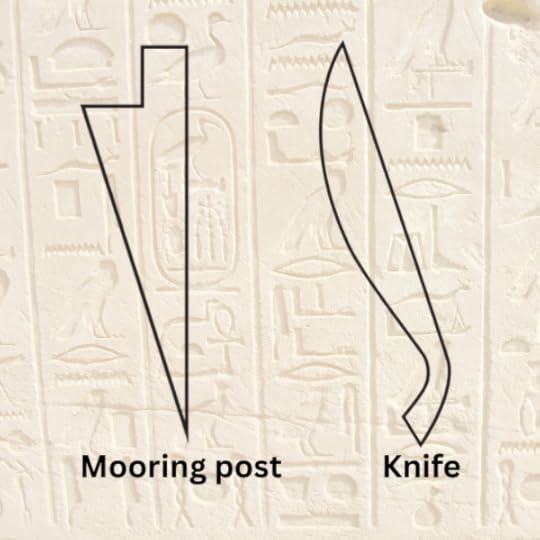
As a hippopotamus Mother Goddess, Iset Reret wields Her own fiercely protective nature and a mooring post of flint.
You can see here that the hieroglyph for “mooring post” and for “knife” are quite similar. So, you’ll probably not be too surprised to learn that, in later periods, the hippo Goddess of the Reret constellation was shown holding a knife rather than the similarly-shaped mooring post.
Knife and mooring post become even more indistinguishable in many apotropaic images of knives being stabbed into the coils of the enemy serpent Apophis (Apop) to defeat and subdue Him.
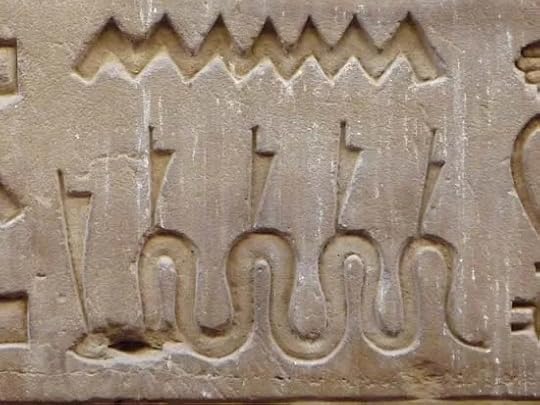 Knives (not mooring posts) subduing Apophis
Knives (not mooring posts) subduing ApophisAll of this is by way of set up for Part 2 of this post next week.
We’ll learn more about the connections between mooring post, knife, and flint—and where fire and Lioness Goddesses come into all this.
We’ll delve deeper into the symbolism of both mooring post and knife and see how they are particularly associated with Divinity and with Isis.
And we’ll talk about what we can do with all this information in our personal magical and spiritual work with Isis.
July 27, 2025
Isis & the Ankh
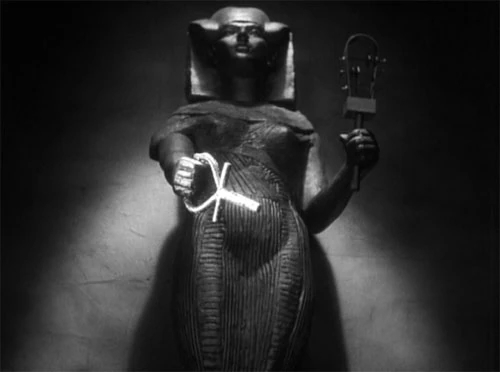
The awesome scene from “The Mummy” when the statue of Isis raises the ankh to save Her reincarnated priestess from a lovestruck but murderous mummy
Of all the emblems of ancient Egypt, the hieroglyphic symbol of the ankh is probably the most familiar. Many people still wear it as an amulet and know that, in Egyptian, ankh means life.
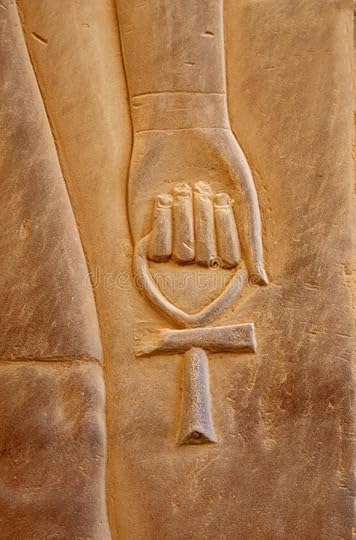 Every Deity has an ankh
Every Deity has an ankhThe ankh was extremely popular in ancient Egypt, too. Egyptians made ankh-shaped vessels, fan bases, sistra, unguent jars, jewelry, mirror cases—in addition to wearing the symbol itself as an amulet. Special bouquets of flowers, formed into the shapes of ankhs and simply called Ankhs, were given as offerings to Deities and as sustenance to the dead. The ankh was carved into temple walls and used to decorate furniture.
In later times, the Coptic Christian church used it as the crux ansata, the handled or “eyed” cross, because of its resemblance to the Christian cross.
Egyptologists still aren’t sure what the familiar oval-and-cross shape originally represented. Some believe it has sexual symbolism because some ankhs have what appears to be a female pubic triangle painted just beneath the cross bar. Others believe it represents a sandal strap. Still others see it as a type of magical knot or bow—similar to the Isis Knot or Tyet, which it closely resembles. Since Egyptian magic frequently employed knots, this idea is not at all far-fetched. Indeed, in some examples of the symbol, you can see what could be folds in the fabric or rope used to tie the knot.
 As you might guess, my favorite bumper sticker
As you might guess, my favorite bumper stickerYet another interpretation combines the knot concept with an idea that may have some merit since it actually connects with the meaning of the symbol itself: life. In this interpretation, the ankh is an umbilical cord that has been looped and tied to a short stick (the cross bar) to create the ankh-shaped amulet. Thus the ankh represents the way Life flows from the Divine to the human in the same way that life flows from the mother to the child through the umbilical cord. There are numerous references to Isis “cutting the navel string” of the reborn Horus. And there is even a myth that Horus recovers the birth cord of His murdered father, Osiris, in order to bury it safely. In a tale about the birth of three kings, the children’s birth cords are cut off, wrapped, and preserved. Clearly, the birth cord had significance.
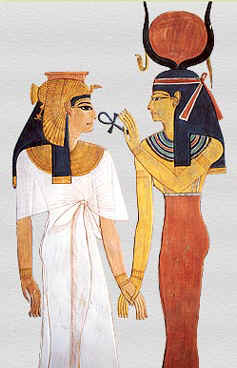 Isis giving ankh to Queen Nefertari
Isis giving ankh to Queen NefertariYet the life symbolized by the ankh is more than simple daily existence. It is also the sacred and ever-renewing principle of Life. It is the Eternal Life with which the Goddesses and Gods imbue humanity. It is the Life that is renewed after death. In funerary art, Deities such as Anubis and Horus pour streams of ankhs over the deceased to symbolize this eternal, regenerating life that flows from the Divine. Goddesses and Gods hold the ankh to the nose of the deceased to revive her or him in the Otherworld.
While the ankh is rightfully a symbol of every Deity, it is also especially appropriate to Isis. On an earthly level, Isis is the Great Divine Mother, the generatrix of all life on Earth. Isis is intimately connected with the fields that bring forth food, the waters that nourish and regenerate the land, and the life-giving air that fills our lungs.
Isis is a Green Goddess of Life, daughter of Earth and Sky. The Coffin Texts call Her She of Vegetation and Mistress of Herbage Who Makes the Two Lands Green. She is a Water Goddess for Her yearly tears for Osiris caused the Nile to overflow its banks, vivifying the land. She is the Queen of the Sea and the Lady Who brings rain. As a Bird Goddess, Isis is Mistress of the Skies and a Lady of Air.
 Isis and Nephthys flanking the ankh, which upholds the solar disk and is supported by the djed column
Isis and Nephthys flanking the ankh, which upholds the solar disk and is supported by the djed columnOn a spiritual level, Isis gives the gift of renewed life after death. Beating Her magical wings, the Goddess fans air—and ankh—into the nose and lungs of Her beloved Osiris. It is Isis’ vital breath that fills the nemset jars with which the deceased is dried after a purifying bath. And it is Isis Who brings the spiritual water that helps regenerate the dead.
As She is the Lady of Life, Isis is the Lady of Life Everlasting. She is the Green Goddess of life on Earth and She is the Divine Mother of each of us Who cuts our navel-string when we are transformed and reborn into Eternal Life.
July 20, 2025
Hymns to Isis at Her Faiyum Temple
 Medinet Madi
Medinet MadiThe Egyptian Faiyum is in middle Egypt. In ancient times, it was an important oasis with its large, freshwater lake, fed by the Nile, and known in Greek as Moeris (from Egyptian Mer Wer, “Great Canal”). Humans have been in the area since pre-Neolithic times and a settlement, called Shedet, was established by the Old Kingdom.
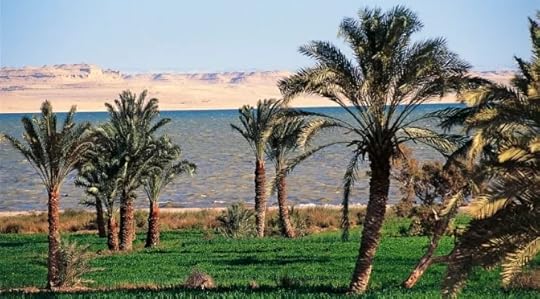 Lake Qarun
Lake QarunThe modern city of Faiyum is about 60 miles southwest of Cairo. The lake, now called Lake Qarun, is still there, but it’s much smaller, landlocked, and hyper-salty.
Anciently, the Faiyum was one of the main cult centers of the Crocodile God Sobek, where He was known as Sobek Shedety, “Sobek, He of Shedet.” Crocodiles, you see, were particularly plentiful in Lake Moeris. It is here in the Faiyum that Isis and Sobek meet up, especially in the temple complex at Medinet Madi (Gk., Narmouthis), at the southwestern entrance to the Faiyum. You can read more about Isis and Sobek here.
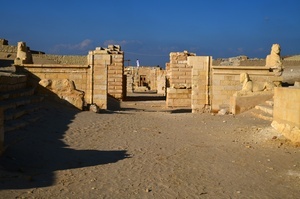 Courtyard at Medinet Madi
Courtyard at Medinet MadiThe Medinet Madi temple was originally built in the 12th dynasty and is the only surviving Middle Kingdom temple found to date. It was first dedicated to Sobek, to the cobra-formed Harvest Goddess Renenutet, and to Horus of Shedet. In the Greco-Roman period, the temple was dedicated to Isis as well.
Isis and Renenutet had long been syncretized, perhaps before the 5th century BCE. You will see the name of the combined Goddess as Isis-Thermouthis, Isis–Hermouthis, or Isis–Ermouthis. There’s also a version that combines the two Goddesses’ names as Isermouthis. So here we have the Goddesses continuing the Egyptian religious understanding of being able to combine, flow into, and “come forth as” each other.
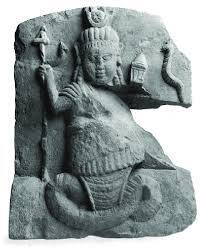 Isis Thermouthis from Medinet Madi
Isis Thermouthis from Medinet MadiCarved on the entrance pillars to the Medinet Madi temple’s forecourt, we find four hymns to Isis. If you read the hymns in order, their placement on the pillars leads the reader from outside the gate to inside the forecourt. In other words, the author of the hymns is leading his readers, through his knowledge of Isis, into Her temple.
Today, I’d like to tell you a little bit about those hymns.
They are the oldest of the famous Isis aretalogies (“speaking of virtues”) found throughout the Mediterranean world and were likely composed in the early part of the first century BCE. Unlike some of the other aretalogies/hymns, we know who composed them for he signed his name: Isidoros. Unfortunately, we don’t know much about Isidoros, other than he was a devotee of Isis and had enough wealth and prestige to have his compositions in Isis’ honor carved in Her temple grounds.
After his signature in the second of the hymns, Isidoros says that he has been given blessings of great happiness by the Deities, so the hymns as a whole may have been a thank offering. In his fourth hymn, Isidoros says that he investigated the history of the temple and “translated” his findings for the Greeks. This has made some scholars suggest that Isidoros may have been a bilingual Egyptian, maybe even a priest, who wanted to share his knowledge of his Goddess Isis with the Greeks. This was during the Ptolemaic period, when Greeks were ruling Egypt, and there were clearly enough Greek-speakers in Narmouthis that Isidoros wanted to write his hymns to the Goddess in Greek.
 Images of Isis-Thermouthis, now in the Louvre
Images of Isis-Thermouthis, now in the LouvreIsidoros’ hymns also demonstrate a blending of Greek and Egyptian religious traditions (the same type of blend we find in the Greco-Egyptian magical papyri, aka, the PGM.)
In these hymns, Isis is a universal Goddess and all powerful. She is benefactress to all human beings, the giver of all life, livelihood, and nourishment. She is the savior from all difficulties. Yet at the same time, She is also a local Goddess, using Her power for and giving Her favor to the people of the Faiyum as they celebrate Her local festivals.
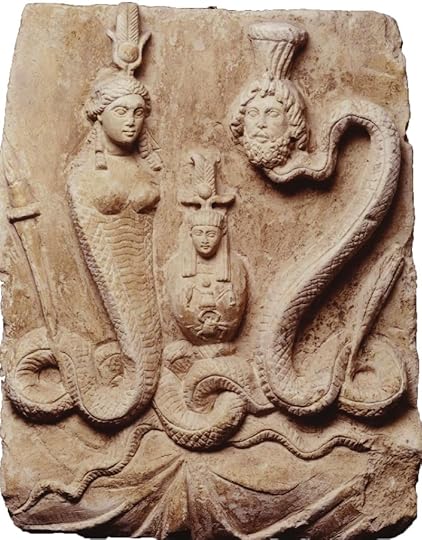 Isis and Sarapis as serpents; between Them is a canopic image of Osiris
Isis and Sarapis as serpents; between Them is a canopic image of OsirisWriting in Greek, and “translating” for Greeks, Isidorus uses a number of phrases also found in Greek epic poetry, as well as Greek poetic forms: hexameters (a rhythmic style) and elegiacs (metrical couplets). Earlier scholarship generally considered that the Greek Isiac hymns and aretalogies merely stuffed Isis into a Hellenized mold. But more recent study has shown that many of the phrases used in the hymns and aretalogies can be traced back to Egyptian originals, including specific Egyptian epithets of the Goddess. For instance, here’s a post on the aretalogy supposed to be from Memphis and the work scholars have done searching for the origins of its praises of the Goddess.
Interestingly, at least one scholar considers Isidorus’ hymns to be quite close to indigenous religious feeling—despite their Greek translations.
So that you can see the hymns for yourself and use or adapt them as you wish, I’ll reproduce two of Isidorus’ hymns, Hymn I and III. The English translations are from Vera Vanderlip’s The Four Greek Hymns of Isidorus & the Cult of Isis. You can download a copy of the whole book here. The work is a bit dated now, but still very valuable.
In Hymn I, we find Isis of the Many Names as a universal Goddess. Isidorus notes that the Egyptians call Her Thiouis, for they know that She, being One, is all Goddesses. Thiouis is a Hellenized version of the Egyptian epithet of Isis, Ta Uaet, “The Only One.”
Isis Hymn I from Medinet Madi temple
O wealth-giver, Queen of the Gods, Hermouthis, Lady,
Omnipotent Agathē Tychē, greatly renowned Isis
Dēo, highest Discoverer of all Life,
Manifold miracles were Your care that you might bring livelihood to mankind and morality to all.
You taught customs that justice might in some measure prevail;
You gave skills that men’s life might be comfortable,
And You discovered the blossoms that produce edible vegetation.
Because of You, heaven and the whole earth have their being; and the gusts of the winds and the sun with its sweet light.
By Your power the channels of Nile are filled, every one, at the harvest season and its most turbulent water is poured on the whole land that produce may be unfailing.
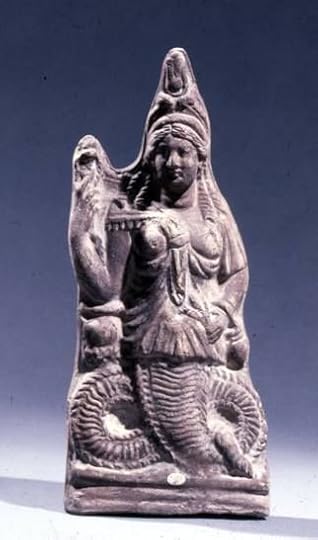 Isis Thermouthis, complete with Isis knot and fringed mantle
Isis Thermouthis, complete with Isis knot and fringed mantleAll mortals who live on the boundless earth, Thracians, Greeks and Barbarians, express Your fair Name, a Name greatly honoured among all, but each speaks in his own language, in his own land.
The Syrians call You Astarte, Artemis, Nanaia. The Lycian tribes call You Leto the Lady; the Thracians also name You as Mother of the Gods. And the Greeks call You Hera of the Great Throne, Aphrodite, Hestia the goodly, Rheia and Demeter.
But the Egyptians call You “Thiouis” because they know that You, being One, are all other Goddesses invoked by the races of men. Mighty One, I shall not cease to sing of Your great power.
Deathless Savior, many-named, mightiest Isis, saving from war, cities and all their citizens: men, their wives, possessions, and children.
As many as are bound fast in prison, in the power of death; as many as are in pain through long, anguished, sleepless nights; all who are wanderers in a foreign land; and as many as sail on the Great Sea in winter, when men may be destroyed and their ships wrecked and sunk, all these are saved if they pray that You be present to help.
Hear my prayers, O One whose Name has great Power; prove Yourself merciful to me and free me from all distress.
Isidoros wrote this.
Isis Hymn III from Medinet Madi temple
O ruler of the Highest Gods, Hermouthis, Lady, Isis, pure and sacred, mighty, of mighty name, Dēo,
O most hallowed bestower of good things; to all men who are righteous, you grant blessings: to possess wealth, a life that is pleasant, and most serene happiness: material gain, good fortune, and happy soundness of understanding.
All who live lives of greatest bliss, the best of men: sceptre-bearing kings and those who are rulers, if they depend on You, rule until old age, leaving shining and splendid wealth in abundance to their sons and sons’ sons, and to men who come after.
But the one whom the heavenly Queen has held most dear of princes, rules both Asia and Europe,
keeping the peace; the harvests grow heavy for him, with all kinds of good things, bearing fruit.
 Isermouthis; remember that Isis can take serpent form as a fire-spitting Eye of Re; the torch She has in this image is harmonious with that ancient understanding
Isermouthis; remember that Isis can take serpent form as a fire-spitting Eye of Re; the torch She has in this image is harmonious with that ancient understandingAnd where indeed there are wars and slaughter of countless throngs, Your strength and Godly power
annihilates the multitude; but to the few with him it gives courage.
Hear me, Agathētychē [“Good Fortune”: that is, Isis], when I pray to You, Lady…
Whether You have journeyed into Libya or to the south wind, or whether You are dwelling in the outermost regions of the north wind ever sweetly blowing,
Or whether You dwell in the blasts of the east wind, where are the risings of the sun,
Or whether You have gone to Olympus, where the Olympian Gods dwell,
Or whether You are in heaven above, a judge with the immortal Gods, or whether You have mounted the chariot of the swift-driving sun, You are directing the world of men, looking down on the manifold deeds of the wicked and gazing down on those of the just.
If You are also present here too, You witness mens‘ individual virtue, delighting in the sacrifices, libations, and offerings of the men who dwell in the nome of Suchos [Sobek], the Arsinoïtes [that is, those who live in the Faiyum], men of mixed races who all, yearly, are present on the twentieth of the month of Pachon and Thoth, bringing a tenth for You and for Anchoēs [Isis’ and Sobek’s son], and Sokonopis [Sobek], most sacred of Gods, at Your feast.
O Hearer of Prayers, Black-Robed Isis, the Merciful—and You Great Gods who share the temple with Her—send Paean to me, Healer of All Ills.
Isidoros wrote this.
For me, these ancient hymns and praises of Isis serve as rich pools of inspiration for my own work. I hope you enjoy reading them and may as serve as inspiration for your own heart-words to Isis.
July 13, 2025
Isis & the “Magical Mindset”

Ritual is how we DO religion.
And to do ritual, we perform a set of prescribed actions and, usually, words. Our rite may be something as simple as sitting quietly and counting our breaths or lighting a candle. Or it may be something as elaborate as an initiation ritual.
Yet just doing a set of actions and reciting specific words is not enough. Another vital component must be present in order to transform the actions and words from rote performance to real participation in the sacred. There must also be an psychospiritual component to our ritual. When the transformation from performance to participation is successful, we are taking part in sacred magic—a term particularly appropriate when it comes to Isis, She Who is Goddess of Magic par excellence. And because She is Lady of Magic—in Egyptian, Iset Nebet Hekau—I consider all Isiac ritual acts to be acts of sacred magic.
This is one of the reasons I was happy—thrilled, actually—to see the recent review of Offering to Isis by Foolish Fish. I was pleased because the reviewer had noticed that I included the ritual visualizations in the dromena, that is, the part of the rite that describes the ritual actions. Dromena might include things like purifying by sprinkling water, consecration with incense, walking a protective circle around your temple, or raising your arms in the Sign of the Wings of Isis—in addition to the breath-counting or candle-lighting already mentioned.

While the physical acts of ritual are important—and sometimes taking the action itself can help trigger the magical mindset when the dromena have been practiced extensively, it is the state of our minds, souls, and spirits—the “magical mindset,” if you will—that makes the ritual work. And by work, I mean that it connects us with the spiritual world, helps us communicate that which we wish to communicate, and helps us transform ourselves and/or our world.
What “mindset” conditions facilitate successful magic? Usually, these are a bit different for each person. Yet, I do think there are commonalities to look for.
For instance, if we can increase our sense of openness, both physically and spiritually, this will help us increase our magical perception. A feeling of expansion—in the heart, in the mind, in the spirit—all help us open ourselves to the Divine. We need to “uncramp” ourselves, loosening body, soul, and spirit. (That’s why we are so often advised to leave the cares of the outside world at the door of our ritual space.) What’s more, if we can cultivate in ourselves a feeling of expectancy and anticipation, we will be helping to create the right conditions for magic to happen.
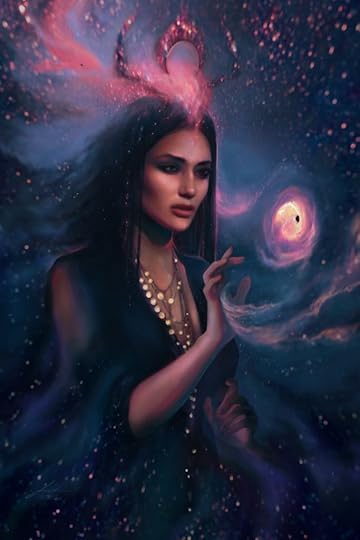 Jeszika Le Vye’s Isis; buy a copy here.
Jeszika Le Vye’s Isis; buy a copy here.We have the ability to attune our hearts and minds, allowing ourselves to enter into these expanded states. And when we do, the result is often a sense of connectedness. When we can take down our walls and remove our masks, we allow ourselves to become more aware of the connections that inevitably exist—connection with the natural world around us, with the symbols of the rite, with the other people who may be in ritual with us. Importantly, we can better perceive our connection with the unseen realms—and with Isis Herself.
This can be easier to describe than to achieve.
On the other hand, I know people—adepts of one tradition or another—who can tune into their magical mindset almost instantly. That’s because they’ve been practicing for many years. Most of us, most of the time, need to work at it in order to transform our everyday mindset into the magical mindset.
One way to do this is through visualization. Visualization is “seeing with the mind’s eye.” Visualization is creative imagination. And it is a powerful magical tool. In the Hermetica, the great Hermetic teacher Hermes Trismegistos (aka the Magician God Thoth) explains, “coming to be is nothing but imagination.” And you might recall that “coming into being” is one of the most common ways ancient Egyptian texts describe the creation of something new. “And so, X came into being,” texts say.
Many people are familiar with guided meditation, in which you try to imagine or “see” the scenes your guide is describing, yet you have your own reactions and experiences within the parameters of the guided visualization. But we can guide our own visualizations, too. I don’t mean just having our own free-wheeling reactions to whatever energy we’ve invoked, but actually guiding what happens and precisely imagining the energies invoked. This is not cheating; indeed, it is a key part of creating your magical mindset.
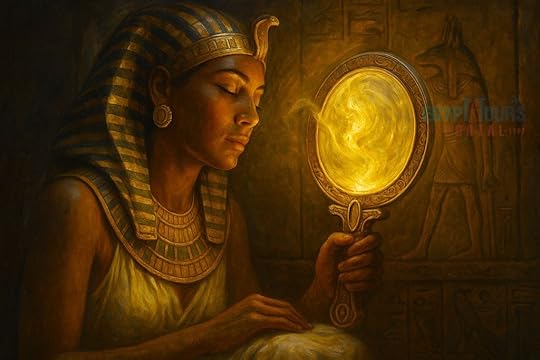
For some, visualization can be difficult. If that is the case for you, don’t be concerned. You may sense the unmanifest realms in other ways: hearing words, sensing things or simply “having a feeling.” Practice describing your perceptions to yourself in ways that make sense to you.
Nevertheless, many, even most, of us can teach ourselves to visualize. I’m probably dating myself here, but I taught myself to visualize using a book called the Silva Mind Control Method. While there are other aspects to the Silva method, to learn visualization, for 30 days in a row, you visualize an apple, each day adding more and more “reality” and sensual perceptions to the visualization. It worked for me.
But if you’re one who simply does not work that way, I’d suggest making your rituals symbol-rich. For instance, if you’re invoking the elements, have symbols of each element in the corresponding quarter of your altar—and know what the symbols mean; study them, read about them. Instead of visualizing, you can physically see and mentally contemplate the symbol, thinking about its meaning as you call-in each element. And don’t forget that words are symbols, too. The words of the ritual, as well as evocative poetry, can help transport us into the magical mindset.
For those who do visualize or would like to, I’ll share an example of how it can be used in ritual.
Let’s say we want to create those conditions of openness, expansion, and expectancy we talked about. This is precisely the purpose of the ritual of “The Opening of the Ways” in Isis Magic. It’s an all-purpose rite intended to create sacred space for communion with the Goddess, for meditation, for offering, or for any other act of sacred magic. In this ritual, we think of our own aura as a temple into which we are inviting the Presence of Isis. We visualize opening each of the directions (or “Ways”) to Isis, so that the energy and Presence of the Goddess can enter our temple.
Here’s what I often visualize:
In each direction (east, west, south, north, above, below, and heart-center) I imagine a pair of Egyptian pillars with translucent curtains closed between them. As I open each of the Ways, I will pull aside the curtains to reveal a scene beyond them.
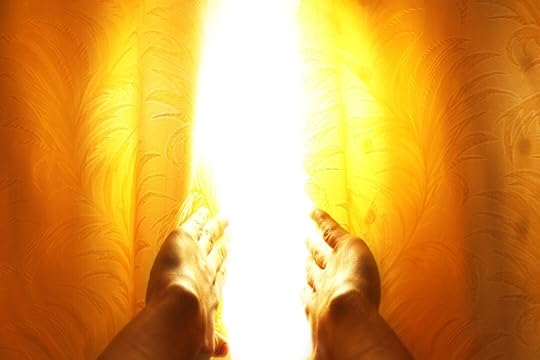
For instance, as my physical body stands facing east with my arms before me, palms together, I prepare to Open the Ways to Isis of the East, the Lady of the Breath of Life, by making the Sign of the Opening of the Shrine.
In my mind, I see the two sculpted, Egyptian pillars, pale-yellow, sandstone colored. I sense that if I were to really look closely at them, I would see Egyptian hieroglyphs showing sails and fans and images of Deities of the Winds. But I need not always do that; for now, I simply see the pillars and the closed curtains before me. With my physical arms in front of me, I feel a bit of tension in my shoulders and arms and know that I will expend real energy when I open those curtains.
I say, “Let the Shrine of the East be opened unto Isis, only Isis,” and I open my arms out—wide—as I vibrate Her name: Iset Nef. I am sure to make this gesture fully in the physical so that I can take a deep breath and feel the openness in my own chest. At the same time, I imagine my hands pulling the curtains to the right and left so that I can now see out to the scene that lies between them.
I “see” that I am standing on a cliff where a cool, morning breeze blows softly as the sun rises in the dawning light. I breathe deeply, understanding that Isis of the Air is entering into my temple, into me, with each breath. I breathe the breath of Isis Herself, as She comes to me, comes to me. By now, I will usually feel something in my body, a tingle of energy, as the magical connection is made and I sense the Presence of Isis of the Air, the Lady of the Winds, the Queen of the Breath of Life.
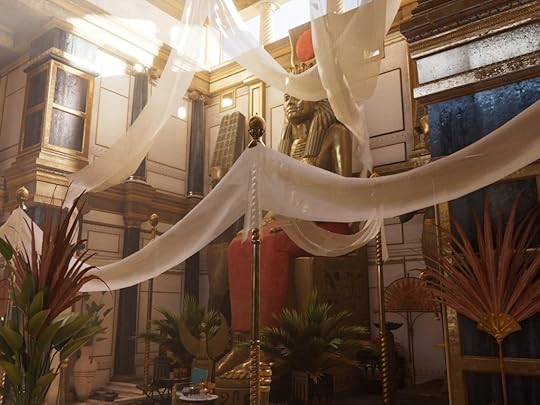
I repeat the same actions, but with different visualizations and Goddess names, at each of the Quarters, above me, below me, and at my heart. (If you want to try it, the ritual is at the link above.)
When I’ve completed these ritual actions and words, along with the visualizations, I should be well on my way to achieving my magical mindset. I will feel much more open, expanded, expectant, and connected, ready to commune with Isis or do any other work of sacred magic.
Even now, just describing it to you, I am almost, almost, almost there.



